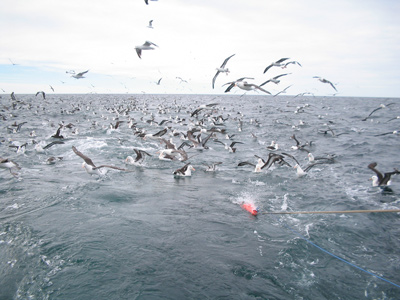Traffic cones used to protect seabirds
Traffic cones used to protect seabirds
WCS
December 11, 2007
Bright orange traffic cones that warn drivers of danger on the road are now being used to steer seabirds away from deadly entanglement in fishing nets, the Wildlife Conservation Society (WCS) reports. Argentinean marine biologist and inventor Diego Gonzalez Zevallos has conducted research funded by WCS and Fundacion Patagonia National on the issue for over five years.
The device, appropriately dubbed the Traffic Cone, dissuades seabirds such as albatross from accidentally striking an exposed cable when they dive for waste discarded by fishing boats. Sea birds often strike the difficult-to-see cables — which are used to lower fishing nets — and are subsequently dragged underwater by the gear.
Research on use of the Traffic Cone aboard commercial trawlers show the number of cable contacts by seabirds was reduced by 89 percent with no seabird fatalities. More importantly, a majority of participating crew members believed the device did not adversely affect fishing success and were therefore willing to adopt the device.
 Photo credit: Diego Gonzalez Zevallos. |
“We’re really excited about this device. It’s very simple but will make a big difference in albatross mortality due to longline fisheries, the primary factor in its endangered status,” said Avecita Chicchon, director of the Latin American and Caribbean Program for WCS.
The nutrient rich waters off the coast of Argentina – critical feeding grounds for many declining species of seabirds and mammals – have attracted increasingly intensive fishing activity in recent years. The competition for fish has proved particularly disastrous for the endangered black-browed albatross.
“It is a simple, cost-effective, practical device that could be easily applied in trawler fisheries operating in Argentine waters and around the world,” said Mr. Zevallos.
He was recently awarded $10,000 for his invention as a runner-up in an international competition sponsored by the World Wildlife Fund.
The Wildlife Conservation Society partners with the Fundacion Patagonia Natural on seabird conservation research and has been working to protect marine mammals and seabirds in this region since 1964.